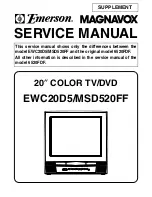
User’s manual · TSQ 310
- 8 - TSQ 310 version_en_1.1 FTE maximal
- Configure all devices:
- Input values to all devices: It allows copying the current input
configuration in all the interconnected modules.
- Modulator values to all devices: It allows copying the
configuration of the current modulator in all the interconnected
modules.
- Output values to all devices: It allows copying the current
output configuration in all the interconnected modules.
- Factory default to all devices: It allows making values by default
to all the interconnected modules.
7. Program management
- New program: This option allows creating a program with the current
configuration of a module or group of modules.
- Load program: It allows loading a previously created program on a module or
group of modules.
- Delete program: It allows deleting a program.
- Device to process:
- Current: The creation or loading of a program will be applied only in the
module that is currently connected.
- All: The creation or loading of a program will be applied to the whole
group of connected modules.
- Working disk: With this option we have the possibility of choosing if we want to
work into the internal disk or in the external storage device USB 2.0.
Once the option is selected, a dialog box will appear and we will be able to choose among three different options:
- Auto: The Meter decides where the data will be stored. If there is external memory connected, the Meter will
store the data in it. If not, it will use the internal memory.
- USB: The Meter always will try to use the external memory connected to the USB port. If this memory has not
been connected an error message will be shown, reminding that there was an error storing the data and it will be
not stored.
- Internal: Always the internal memory is used to store the data.
- Load programs from USB: This option allows importing programs from a USB memory to the field strength meter. Before
using this option you must connect a USB memory.
- Save programs to USB: This option allows copying the programs stored in the external USB 2.0 storage device.
- Write Alias: It allows saving the alias of the module in the program. Options: Yes/No
8. Set Output Services
This option allows making the selection of the services that you wish to include in
the output multiplex.
- Add/Remove services: It allows adding the services to the multiplex and also
removing the ones previously included. The lower bar informs about the available
space in the output multiplex. As you add more services, the space available will
decrease.
Once you have tuned a transponder in the “Input Set Up” section and you have
selected the DVB-C modulator configuration in the “Modulator Set Up” section,
you can make the assignment of the services that are going to be included in the
output multiplex “Adding/Removing services”.


































